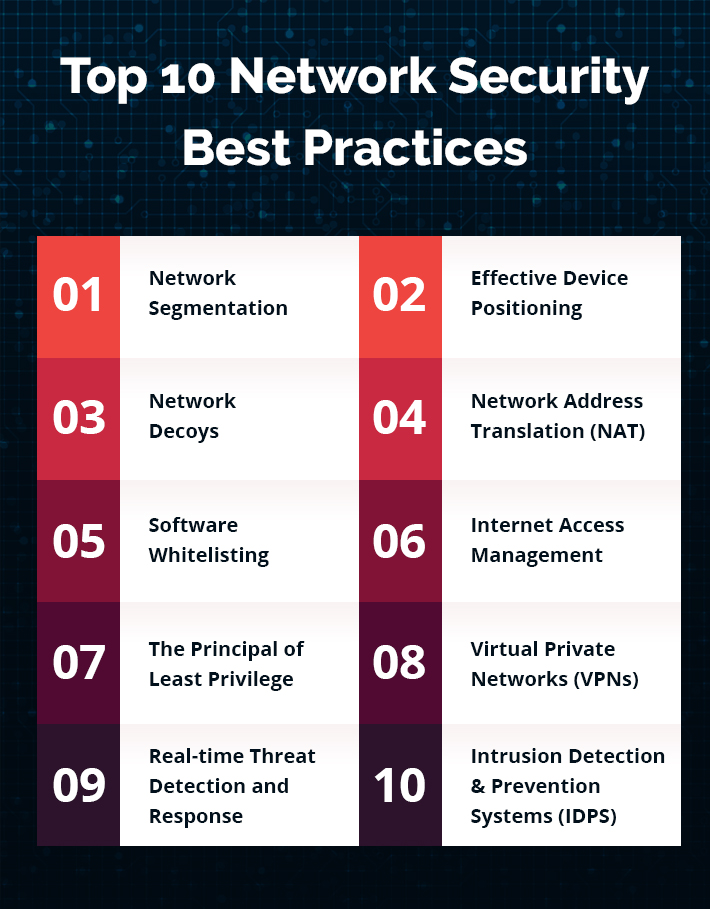Last Updated on December 20, 2024 by Deepanshu Sharma

Network security encompasses the policies, processes, and practices designed to prevent unauthorized access, detect and monitor misuse, prevent modification, and prevent denial of access to computer networks and resources. According to the 2023 Data Breach Investigations Report, 80% of hacking-related breaches are the result of brute force DDoS attacks or stolen data or lost credentials, thus highlighting the importance of a robust network security strategy.
Network Devices
Network security is reliant on a range of devices that facilitate seamless communication and data transfer. These devices include:
- Network switches, which connect devices within a local area network (LAN) using Media Access Control (MAC) addresses.
- Routers, which direct data packets between different networks, granting internet access and enabling internal communication within the network.
- Gateways, which play a crucial role in enabling communication between devices using different protocols, ensuring compatibility and facilitating information exchange.
- Load balancers, which distribute network traffic across multiple servers, preventing overload and ensuring that critical network resources are evenly allocated.
Importance Of Network Security
Businesses must prioritize network security to safeguard their sensitive data and IT systems. This is crucial because it prevents unauthorized access, tampering, and theft of personal information and business secrets. For businesses that handle customer data, a breach can result in significant financial and reputational losses. By implementing network security, businesses can ensure the smooth operation of their IT systems, reduce the risk of system downtime and associated costs, and optimize resource usage, preventing slowdowns and crashes.
Network Security Best Practices
Below are some of the best practices for securing your network:

1. Network Segmentation
Network segmentation involves dividing a network into distinct, logical, or functional zones, limiting the spread of potential threats and reducing the attack surface. This is achieved through the use of physical devices such as routers and switches, as well as virtual means like Virtual Local Area Networks (VLANs). By creating these separate zones, network administrators can restrict the movement of unauthorized traffic and contain any potential security breaches, minimizing the disruption and damage caused by an attack.
2. Effective Device Positioning
To ensure optimal security, it is crucial to thoughtfully position your devices to maximize their effectiveness. This involves strategically placing firewalls at each network zone junction, ensuring seamless control over data flow and safeguarding against potential threats. Additionally, web application firewalls (WAFs) should be deployed in zones where applications are hosted, such as the Demilitarized Zone (DMZ), to provide an extra layer of protection against malicious attacks. Additionally, load balancers and DNS servers should be situated in the DMZ, allowing for efficient traffic flow and enhanced security.
3. Network Decoys
Network decoys are a sophisticated security tool that can detect lateral movement activities in your network environment by mimicking real assets on your network. These decoys can be deployed in various areas, including business-critical network segments, demilitarized zones, key applications, databases, and cloud environments. By deploying network decoys, you can lure attackers into interacting with fake assets to gain valuable insights into their tactics.
4. Network Address Translation (NAT)
Network Address Translation (NAT) is a technology that enables private networks to communicate with the public internet while maintaining their internal structure hidden from outsiders. This is achieved by translating private IP addresses to a single public IP address, making it appear as if all devices on the internal network are connected to the external network under a single IP address. Additionally NAT integrates seamlessly with personal firewalls, which can be configured on each computer or server to restrict incoming and outgoing traffic, providing an additional layer of security to protect devices from unauthorized access. By combining NAT with personal firewalls, organizations can maintain a secure and private network environment while still allowing their devices to access the public internet.
5. Software Whitelisting
Software whitelisting has emerged as a cutting-edge strategy to safeguard against the constant threat of malware and hacking. By meticulously curating a list of authorized software, this approach ensures that only trusted applications are permitted to run on a system, thereby blocking any unauthorized or malicious code from infiltrating the network. This proactive approach not only reduces the risk of malware infections but also prevents potential hackers from exploiting vulnerabilities in the system.
6. Internet Access Management
By using a web proxy server, organizations can effectively manage and monitor internet access, thereby maintaining a secure digital environment. This approach enables organizations to authenticate and track all outbound connections, ensuring that only authorized and legitimate web traffic is permitted.
7. The Principal of Least Privilege (PoLP)
Implementing the principle of least privilege (PoLP) is a crucial security measure that ensures the effectiveness of access controls. By restricting each user’s access rights to only what is necessary for their designated role, we minimize the potential for damage caused by either accidental or intentional actions. By doing so, we significantly reduce the attack surface and mitigate the risk of unauthorized actions, providing a more robust and secure environment for our users and data.
8. Virtual Private Networks (VPNs)
To ensure secure and private access to the network, it is advisable to require the use of Virtual Private Networks (VPNs) for remote access. This means that remote users will be able to establish a secure and private connection over a public network, allowing them to connect to the network as if they were physically located on the premises. By requiring VPNs, we can guarantee that sensitive data and communication remain protected from unauthorized access, maintaining the integrity and confidentiality of our network.
9. Real-time Threat Detection and Response
To stay ahead of emerging threats, organizations must adopt a proactive approach to cybersecurity. This involves establishing a robust baseline of network activity to detect deviations from normal behavior, allowing for the swift identification and response to potential threats.
10. Intrusion Detection & Prevention Systems (IDPS)
An intrusion detection and prevention system (IDPS) is a cutting-edge security solution that monitors a network for potential threats. Both IPDS and IDS (intrusion detection systems) are equipped to identify and alert on potential threats. However, IDPS stands out by taking a more holistic approach, actively working to remediate and prevent threats from causing harm.
Network Security Solutions
Network security solutions work together to create a robust defense mechanism against data breaches. These solutions include:
- Firewalls, which act as a gatekeeper, separating one network from another.
- Network Access Control (NAC) systems, which evaluate devices before granting access to the network.
- Web filters, which block access to unwanted online content.
- Proxy servers, which act as intermediaries, masking IP addresses and filtering web requests. Email filters, which prevent spam emails from reaching user inboxes, reducing the risk of malware and phishing attacks.
- DDoS mitigation tools, which identify and prevent distributed denial of service attacks, ensuring the availability of critical network resources.
By following these best practices and adopting a diverse range of security solutions, organizations can effectively detect and respond to network security threats, ultimately reducing the risk of a security breach and protecting their critical assets.
Benefits of Network Security
Below are the three most notable benefits of network security:
1. Protection of Critical Data
A secure network is essential to protect sensitive data, including customer, financial, and employee data, which can prevent identity theft, fraud, and reputation damage. This can be achieved through robust security measures such as encryption, firewalls, and employee training.
2. Prevention of Cyber Threats and Data Breaches
A secure network is crucial in preventing cyber threats, data breaches, and costly downtime. This can lead to financial losses, damage to reputation, and loss of trust among customers and stakeholders. Strong network security measures, such as encryption and limiting network access, can help prevent these threats.
3. Regulatory Compliance and Protection from Legal Consequences
A secure network is necessary to ensure compliance with regulations, such as GDPR, HIPAA, and CCPA, to avoid fines and legal repercussions. Additionally, a secure network protects against legal consequences, such as identity theft and fraud, which can result in significant financial losses and damage to reputation.
If you’d like to see how the Lepide Data Security Platform can help to detect and respond to threats within your network, schedule a demo with one of our engineers.


 Group Policy Examples and Settings for Effective Administration
Group Policy Examples and Settings for Effective Administration 15 Most Common Types of Cyber Attack and How to Prevent Them
15 Most Common Types of Cyber Attack and How to Prevent Them Why AD Account Keeps Getting Locked Out Frequently and How to Resolve It
Why AD Account Keeps Getting Locked Out Frequently and How to Resolve It
